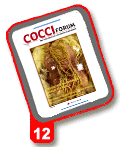COCCI News
Trends and research affecting coccidiosis management
Late production E. maxima problems linked to anticoccidial resistance|
https://cdn.globalagmedia.com/poultry/legacy/cocciforum/coccinews1.jpg" width="180" style="margin-bottom:4px;">
Mathis: 'Increases the chance for late problems'
|
An earlier study suggested that E. acervulina can interfere with E. maxima colonization. Consequently, Mathis designed a battery cage study to examine the relationship of E. acervulina sensitivity to the ionophore salinomycin and subsequent infection levels with E. maxima.
Birds were fed nonmedicated feed or salinomycin at the rate of 60 grams/ton and were then challenged with either a salinomycin sensitive strain of E. acervulina, a resistant strain of E. acervulina and/or an E. maxima field isolate.
The oocyst per bird challenge levels were as follows:
- None (control)
- E. acervulina (sensitive strain) 50,000
- E. acervulina (resistant strain) 50,000
- E. acervulina (sensitive strain ) 50,000 plus E. maxima 5,000
- E. acervulina (resistant strain) 50,000 plus E. maxima 5,000
- E. maxima 5,000
Salinomycin controlled the sensitive strain with 5% weight reduction and 1.25 lesion score. It did not control the resistant strain, resulting in a 22% weight reduction and 2.75 lesion score.
Birds infected with E. maxima and the sensitive E. acervulina strain had E. maxima lesion scores of 2.25. The birds infected with E. maxima and the resistant E. acervulina strain had E. maxima lesion scores of 1.30.
"From the results it can be inferred that E. acervulina interfered with development of E. maxima," Mathis says. "Higher anticoccidial resistance allows more E. acervulina colonization, which appears to interfere with colonization of E. maxima, and thus indirectly slows E. maxima immunity development."
This increases the chance for late problems with E. maxima, possibly explaining an increase in field reports of late E. maxima infections where salinomycin has been extensively used, Mathis adds.
|
Water potential carrier of coccidia Drinking water may be a potential carrier of coccidia to chickens, according to a French study. The study focused on 24 farms that used forage or surface water and did not include farms supplied by treated water. Fecal samples from the farms showed that 75% of the flocks were positive for coccidia. When filters were placed to capture oocysts where water entered the buildings, four of the samples were positive for coccidia. The species of coccidia found in the water was Eimeria acervulina, which was also present in litter from farms in the study. These preliminary results suggest that water can be a potential carrier of coccidia for chickens. |
|
Study shows Coccivac antigens protect
against recent field isolates The antigens in Coccivac vaccines provide good protection against coccidia in the field, according to the results of a controlled study. Chickens were orally immunized with one dose of either Coccivac-B, a coccidiosis vaccine for broilers, or Coccivac- D, a coccidiosis vaccine for breeders and layers. There were 70 birds in each group and a third group, comprised of unimmunized hatch mates, served as positive controls for the study, which was designed to compare the antigenicity of coccidia in the field against the antigenicity of antigens in the vaccine. After immunization, birds in the study were placed into floor pens on clean wood shavings and grown to about 35 days of age. They were then challenged with three predominant species of coccidial field isolates that were collected from 60 broiler and breeder pullet farms across the United States. From 144 to 156 hours after challenge, the birds were euthanized and examined for gross coccidial lesions. In addition, mucosal scrapings from multiple intestinal sites were taken and examined microscopically with a compound light microscope and the severity of parasitic infection was scored. The average level of protection provided by the vaccines was determined to be 97% for Eimeria acervulina, 86% for Eimeria maxima and 91% for Eimeria tenella. Compared to the unimmunized birds, the birds vaccinated with Coccivac-B or Coccivac-D demonstrated substantial immunity as determined by the level of parasitism. |
|
Lesser known Eimeria
species underestimated One of the lesser-known Eimeria species in poultry may be underestimated in importance. Dr. Steve H. Fitz-Coy, of Schering- Plough Animal Health, explains that E. mivati is a coccidial species that some researchers have considered to be a variant of E. acervulina or a mixture of E. acervulina and E. mitis, but not a unique species. To further determine whether E. mivati is unique, Fitz-Coy obtained several field isolates from Georgia and the Delmarva Peninsula that fit descriptions of the species. He selected three of the isolates and sent them with 10 other Eimeria species samples to an independent lab for polymerase chain reaction (PCR) assay. The identity of each sample was not known by the lab. "The only isolates that could not be identified by PCR assay were the E. mivati samples," he reports. The current primers for identification of Eimeria species include E. acervulina and virtually all the other Eimeria species known to affect chickens - except E. mivati. The PCR test indicates that E. mivati is, in fact, a valid and unique Eimeria species, he said. E. mivati is also "moderately pathogenic" in chickens and, on some occasions, can cause mortality, according to Fitz-Coy. In one study, mortality was 40% in naive chickens, but there was no pathology in hyper-immunized hatch-mates. |
|
Sanderson: Organic going mainstream The all-natural food trend is gaining momentum and attracting the attention of larger poultry producers, according to Joe Frank Sanderson, chairman and CEO of Sanderson Farms. He says the trend is not only showing up in the company's research, it is in evidence elsewhere, according to a report in Watt Poultry USA's July 2006 issue. Sanderson points to the successful development of the Whole Foods grocery chain. In addition, most traditional grocery stores now offer organic products and promotion and even Arby's fast food chain is promoting allnatural chicken. All-natural products were considered a small niche market that now appears to be burgeoning and "I predict this trend will continue," he says. |
Source: CocciForum Issue No.12, Schering-Plough Animal Health.







